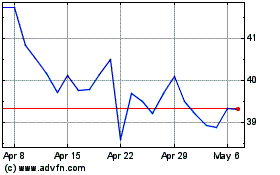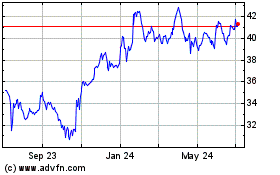Bethpage, N.Y.—When employees at the small cable operator
Suddenlink Communications requested money to fix a broken ice
machine in West Virginia, they weren't expecting so many
questions.
But during a March "investment committee" meeting, executives
from the company's new owner, Altice NV, quizzed them on everything
from the differences between various ice-machine suppliers to
whether it was better to buy or lease. "A complete waste of
people's time and energy," said one former Suddenlink employee.
Altice views it as cost discipline. "That's our whole
philosophy," said Charles Stewart, chief financial officer of
Altice's U.S. unit. "It triggers a discussion at a very
nitty-gritty level, which is where the difference is made."
The European telecom company's strategy of drastically reducing
costs as it expands globally will soon face its biggest test yet as
it digests the $17.7 billion acquisition of New York cable operator
Cablevision Systems Corp., six months after its $9.1 billion
acquisition, including debt, of Suddenlink.
Altice is under pressure to prove that its formula of slashing
expenses on everything from customer call centers to set-top boxes
and then reinvesting those savings in networks and services can
lead to subscriber growth in the mature U.S. cable market. Altice
has promised to squeeze out an ambitious $900 million in cost
savings from Cablevision, including by reducing programming costs
as channel contracts come up for renewal.
A lot is riding on Altice's success in the U.S. Its shares have
declined 59% in the past 12 months as investors questioned the
effectiveness of Altice's strategy and its debt burden, which is
forecast to increase to just above $50 billion by the end of this
year. While its cost-cutting has helped boost the bottom line,
Altice has yet to prove that it can deliver sales growth.
Some U.S. cable executives question whether Altice's playbook
with St. Louis-based Suddenlink, a more rural operator that it
purchased last year, can work at Cablevision, which faces intense
competition from Verizon Communications Inc.'s Fios service and
already has 3 million customers that account for a relatively high
percentage of its greater New York service area.
In a series of interviews in New York last week during their
first 48 hours of owning Cablevision, Altice executives made no
secret of their bigger ambitions to end up in the top two in U.S.
cable.
"It's easier to go from No. 4 to No. 1 than it is from number
zero to No. 4," Altice founder and controlling shareholder Patrick
Drahi told employees as he helped change a "Cablevision" sign to
"Altice" last week, standing on a construction worker's orange
hydraulic lift. "This is the first day of paradise."
Asked about a potential bid for No. 2 Charter Communications
Inc. after this year's integration of Cablevision, Altice USA Chief
Executive Dexter Goei said he is going to be patient. "There can be
a couple of meaningful acquisitions before thinking about something
as large as that," he said.
One challenge for future deals is that some of the only
remaining sizable U.S. cable operators, such as Cox Communications
Inc. and Mediacom Communications Corp., are controlled by families
and not public shareholders. Altice executives said they would also
look for deals in wireless and content.
At Suddenlink, Altice created an authoritarian investment
committee that scrutinizes every expense in hourslong meetings each
week, as it does with all of its takeovers and will do with
Cablevision. The goal is to use Altice's global clout to negotiate
better deals with suppliers.
"It creates consternation for about two months," Mr. Goei said.
"Then people realize, 'Boy, I really don't want to go to the
investment committee. We just got 500 printers a year ago; we can
probably extend their life one more year.'"
At Suddenlink, Altice didn't announce job cuts when the deal
closed. Instead, workers have exited in threes and fours each week
as Altice has created new teams, contributing to what one former
Suddenlink employee called a "culture of fear." An Altice spokesman
said the departures represented normal churn.
The contrast between Cablevision's former owners—the Dolan
family of New York—and Altice's executives was on stark display in
recent days.
Altice's top executives dined in the staff canteen on their
first day after the deal closed, much to the surprise of several
Cablevision employees. Cablevision's former CEO James Dolan would
rarely be seen outside the executive suite and was often
accompanied by bodyguards outside the building.
While Altice has told New York regulators it won't reduce
customer-facing jobs for four years, it is looking for other cuts.
In the past few weeks, Altice has given Cablevision the blessing to
close Freewheel, the Wi-Fi mobile service it launched last
year.
Altice executives also said they would focus on channel-carriage
costs, which have ballooned in recent years. "We have about half of
our programming lineup that's up for renewal very soon," Mr. Goei
said. "There is clearly a lot of channels that we'd like to get rid
of." But he noted many networks are part of broader programming
deals that require all of a company's channels to be carried.
Last week, curious Cablevision employees streamed out to
congratulate Mr. Drahi as he roamed Cablevision's Long Island
headquarters—a far cry from Altice's appearances in France where it
has been met by union protests. He told them about his first
company, "South Cablevision," which he started at age 28.
"This has been our life: every year we are a bigger group," he
said. "For us, everything is possible."
Write to Nick Kostov at Nick.Kostov@wsj.com and Shalini
Ramachandran at shalini.ramachandran@wsj.com
(END) Dow Jones Newswires
June 28, 2016 10:45 ET (14:45 GMT)
Copyright (c) 2016 Dow Jones & Company, Inc.
Verizon Communications (NYSE:VZ)
Historical Stock Chart
From Mar 2024 to Apr 2024

Verizon Communications (NYSE:VZ)
Historical Stock Chart
From Apr 2023 to Apr 2024
